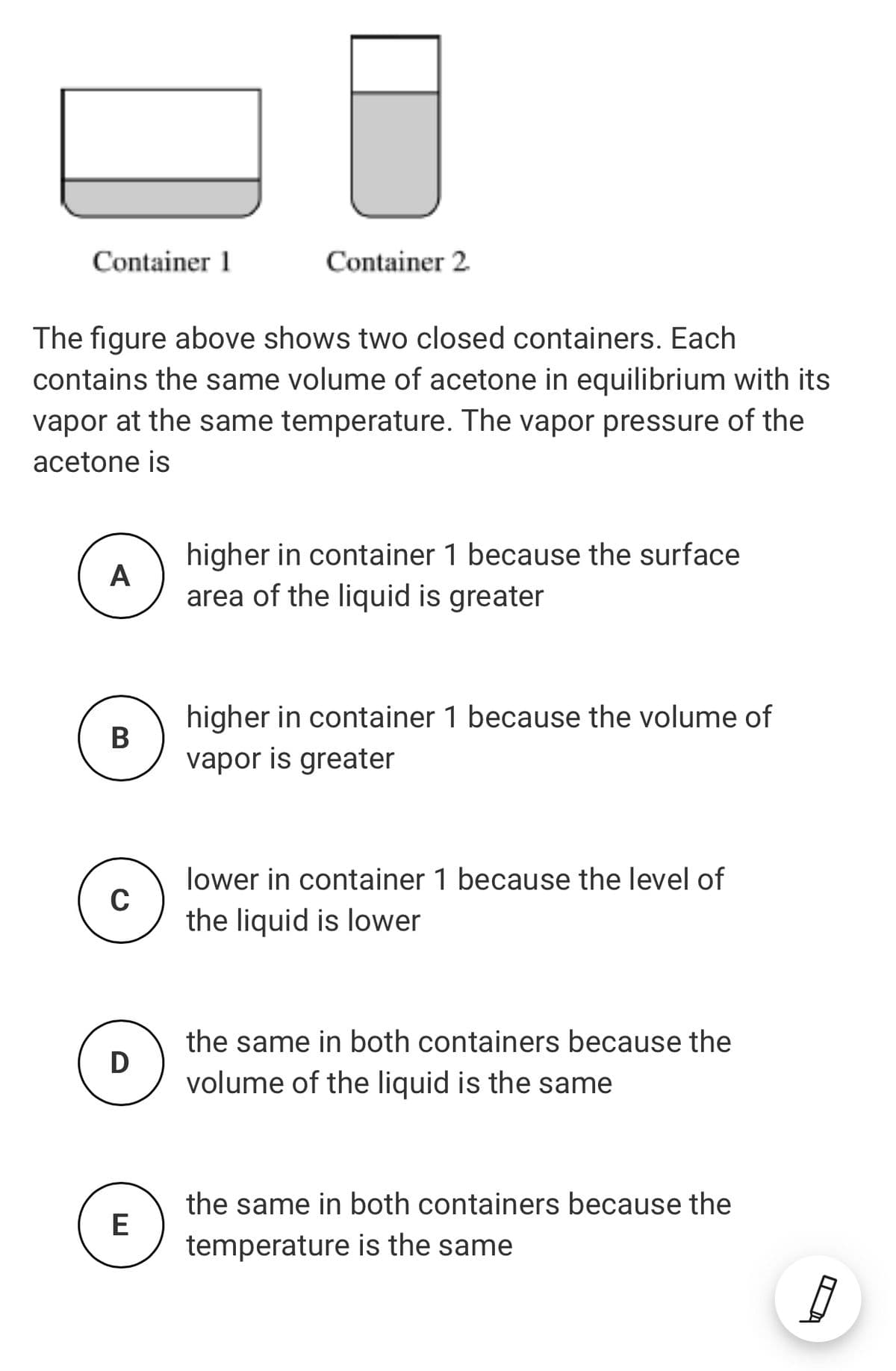Container 1 Container 2 The figure above shows two closed containers. Each contains the same volume of acetone in equilibrium with its apor at the same temperature. The vapor pressure of the acetone is higher in container 1 because the surface area of the liquid is greater A higher in container 1 because the volume of B vapor is greater lower in container 1 because the level of the liquid is lower the same in both containers because the volume of the liquid is the same the same in both containers because the E temperature is the same
Container 1 Container 2 The figure above shows two closed containers. Each contains the same volume of acetone in equilibrium with its apor at the same temperature. The vapor pressure of the acetone is higher in container 1 because the surface area of the liquid is greater A higher in container 1 because the volume of B vapor is greater lower in container 1 because the level of the liquid is lower the same in both containers because the volume of the liquid is the same the same in both containers because the E temperature is the same
Chemistry: The Molecular Science
5th Edition
ISBN:9781285199047
Author:John W. Moore, Conrad L. Stanitski
Publisher:John W. Moore, Conrad L. Stanitski
Chapter9: Liquids, Solids, And Materials
Section: Chapter Questions
Problem IISP
Related questions
Question

Transcribed Image Text:Container 1
Container 2
The figure above shows two closed containers. Each
contains the same volume of acetone in equilibrium with its
vapor at the same temperature. The vapor pressure of the
acetone is
higher in container 1 because the surface
area of the liquid is greater
A
higher in container 1 because the volume of
vapor is greater
lower in container 1 because the level of
C
the liquid is lower
the same in both containers because the
D
volume of the liquid is the same
the same in both containers because the
E
temperature is the same
Expert Solution
This question has been solved!
Explore an expertly crafted, step-by-step solution for a thorough understanding of key concepts.
This is a popular solution!
Trending now
This is a popular solution!
Step by step
Solved in 2 steps

Knowledge Booster
Learn more about
Need a deep-dive on the concept behind this application? Look no further. Learn more about this topic, chemistry and related others by exploring similar questions and additional content below.Recommended textbooks for you

Chemistry: The Molecular Science
Chemistry
ISBN:
9781285199047
Author:
John W. Moore, Conrad L. Stanitski
Publisher:
Cengage Learning

Chemistry & Chemical Reactivity
Chemistry
ISBN:
9781133949640
Author:
John C. Kotz, Paul M. Treichel, John Townsend, David Treichel
Publisher:
Cengage Learning

Chemistry & Chemical Reactivity
Chemistry
ISBN:
9781337399074
Author:
John C. Kotz, Paul M. Treichel, John Townsend, David Treichel
Publisher:
Cengage Learning

Chemistry: The Molecular Science
Chemistry
ISBN:
9781285199047
Author:
John W. Moore, Conrad L. Stanitski
Publisher:
Cengage Learning

Chemistry & Chemical Reactivity
Chemistry
ISBN:
9781133949640
Author:
John C. Kotz, Paul M. Treichel, John Townsend, David Treichel
Publisher:
Cengage Learning

Chemistry & Chemical Reactivity
Chemistry
ISBN:
9781337399074
Author:
John C. Kotz, Paul M. Treichel, John Townsend, David Treichel
Publisher:
Cengage Learning

World of Chemistry, 3rd edition
Chemistry
ISBN:
9781133109655
Author:
Steven S. Zumdahl, Susan L. Zumdahl, Donald J. DeCoste
Publisher:
Brooks / Cole / Cengage Learning

Chemistry: Principles and Practice
Chemistry
ISBN:
9780534420123
Author:
Daniel L. Reger, Scott R. Goode, David W. Ball, Edward Mercer
Publisher:
Cengage Learning

Introductory Chemistry: A Foundation
Chemistry
ISBN:
9781337399425
Author:
Steven S. Zumdahl, Donald J. DeCoste
Publisher:
Cengage Learning